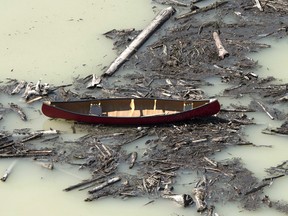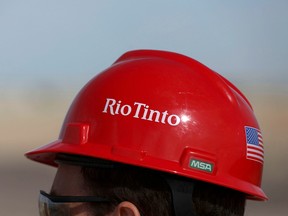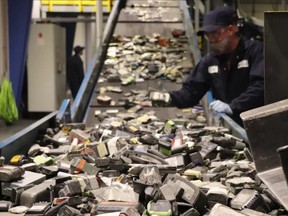[ad_1]
What was waste in years past may not be waste anymore and indeed, may be valuable

Article content
In the middle of the night in August 2014, the Mount Polley Mine Dam in British Columbia failed, spilling an estimated 25 million cubic meters of tailings and wastewater from an open pit copper and gold mine onto the valley below. The damage to the environment and everyone who lived nearby or visited the area was, by some measures, incalculable.
Advertisement 2
Article content
But it wasn’t the first time that a mine’s tailings dam had failed — nor would it be the last. Such disasters highlight a key issue hanging over the mining sector: where to store waste from mines, whether in tailings dams or piles on the ground.
Article content
As efforts to limit climate change lead to more and more investment in electrification, which adds exponential new demand for copper, nickel and many other conductive metals, the environmental track record of mining companies is facing heightened scrutiny from investors and the world.
In response, a wave of entrepreneurs — sometimes supported by larger mining companies — are studying waste from old mining operations and discovering that what was waste in years past may not be waste anymore and indeed, may be valuable.
Advertisement 3
Article content
“We are seeing tailings being evaluated more and more for metals extraction,” said Kiril Mugerman, chief executive of Boucherville, Que.-based Geomega Resources Inc., which is focused on recycling. “It’s already crushed and ground up, so it’s easy to work with, and so more and more processes will be evaluated to extract material from mining tailings.”
The company announced earlier this year that mining giant Rio Tinto PLC, the Quebec government and the federal government’s Sustainable Development Technology Canada would invest $4 million in Geomaga’s Innord Inc. subsidiary to refine a metal extraction process from bauxite waste. The rock is the world’s main source of aluminum, but is also often laden with iron ore and other metals. Mostly mined for aluminum alone, any other metals contained in bauxite historically have been treated as waste — called residues or red mud — and set aside, sometimes in piles.
Advertisement 4
Article content

Mugerman estimates that 150 million tonnes of bauxite residues are produced annually around the world, and that on average, there’s $80 to $120 worth of metal in every tonne.
In the past, Mugerman said research into bauxite waste may have focused on how to grow vegetation in it, or how to store it safely.
“A lot of the money went into how can we make sure it doesn’t look bad, but in terms of actually creating value and giving value to all the metals, there’s very, very little work,” he said. “It’s very, very complex, but we think there’s a solution.”
Mugerman’s move towards recycling was also born out of necessity. Separately from the bauxite residue research, Geomega is building a demonstration plant in Quebec where it hopes to recycle rare earths magnets. It created that project as a means to generate enough revenue to build a rare earths mine one day, which typically involves higher upfront capital costs than a recycling facility.
Advertisement 5
Article content
“We felt like it was an easier way to demonstrate that our technology can be scaled up because in the mining space, you need cash flow,” he said.
Geomega isn’t the only company zeroing in on rare earths recycling. In Kingston Ont., Cyclic Materials Inc. was born when Ahmad Ghahreman, a professor at Queens’ University’s mining department, struck on the recycling idea and took a leave of absence to start the company.
Ghahreman said that though most rare earths magnets end up in landfills, a small percentage are recycled. But he said the process involves burning products to separate out the metals, an inefficient method that can release its own emissions, counteracting any of the hoped-for environmental benefits of recycling.
Advertisement 6
Article content
-

Toronto’s Li-Cycle leapfrogs miners in the green transition by focusing on recycling metals
-

Canadian battery recycler teams up with global commodity giant in supply deal for crucial EV metals
-

Ontario to apologize today to miners forced to inhale aluminum powder for years
Trained in hydrometallurgy — and previously employed by Toronto-based mining giant Barrick Gold Corp. — Ghahreman has developed a process that uses a water-based solution to recycle rare earths magnets. He recently completed a bench scale test designed to show his method works and is now raising money to further develop the technology at scale.
“There’s a lot of economic and environmental benefits to recycling,” he said on the Financial Post’s Down to Business podcast.
Advertisement 7
Article content
Rare earths can be mined, Ghahreman said, but in general the deposits tend to be smaller scale, which means they may not provide the returns on capital that attract investors. It’s one of the reasons why rare earths production and processing has largely moved out of North America during the last two decades. He estimated that within that timeframe, 93 per cent of rare earths magnet production moved to China, where iron ore mines produce rare earths as a byproduct, and where the government has invested heavily in technology to refine and produce rare earths magnets.
Finding low-cost sources of rare earths, including from waste piles, is a major driver of growth in the North American supply chain over the past few years. For example, in July 2021, Toronto-based Neo Performance Materials Inc. announced it had struck a deal with Colorado-based Energy Fuels Inc., a uranium mining company, for a new source of rare earths. Under the agreement, Energy Fuels will provide Neo with monazite sands — a byproduct of other mining operations — that contain rare earths elements.
Advertisement 8
Article content
“It was a hugely capital efficient project,” Constantine Karayannopoulos, chief executive of Neo, said.
Researchers are also looking for resourceful ways to source metals in the battery supply chain. In a 2021 report titled “Reducing new mining for EV battery metals for U.S.-based environmental advocacy non-profit Earthworks, researchers at Australia’s Institute for Sustainable Futures at University of Technology Sydney concluded it was technically possible to recover up to 90 per cent of the copper, cobalt, lithium and nickel found in a lithium-ion battery.

Although current recovery rates are much lower, the report noted that the energy transition is spurring new investment in recycling.
“As greater priority is given to a circular economy approach, novel reuse strategies are also being developed,” the report said.
Advertisement 9
Article content
Companies in Canada are also working on recycling strategies. Toronto-based Li-Cycle Resources Corp. has raised hundreds of millions of dollars and opened facilities around the world to collect electronic waste and battery metal scrap, which it then ships to a refinery where lithium, nickel, cobalt and other metals are extracted.
Tim Johnston, Li-Cycle’s co-founder and executive chairman, has estimated that in several decades, recycling could account for 75 to 80 per cent of the material in the electric-vehicle battery supply chain.
“We can produce the materials cheaper than what they can mine them for,” Johnston said. “We can refine them cheaper than they can refine them.”
• Email: gfriedman@postmedia.com | Twitter: GabeFriedz
Listen to Down to Business for in-depth discussions and insights into the latest in Canadian business, available wherever you get your podcasts. Check out the latest episode below:
Advertisement
[ad_2]
Source link









